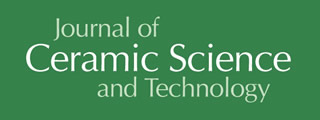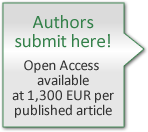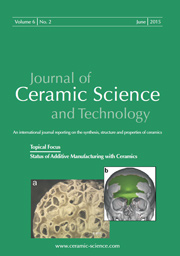Articles
All articles | Recent articles
Effect of Chemical Interaction on Texture Development in Bi4Ti3O12 using SrBi4Ti4O15 and SrBi8Ti7O27 Hetero-Templates
K. Onodera, T. Kimura
Graduate School of Science and Technology, Keio University, 3 – 14 – 1 Hiyoshi, Kohoku-ku, Yokohama 223 – 8522 Japan
received June 18, 2012, received in revised form July 27, 2012, accepted August 20, 2012
Vol. 3, No. 3, Pages 131-140 DOI: 10.4416/JCST2012-00022
Abstract
The hetero-templated grain growth method was applied to the development of texture in materials with the Aurivillius structure. When the template volume fraction was 0.20, the hetero-templated grain growth process developed texture in SrBi4Ti4O15 (SBT) matrix grains based on plate-like Bi4Ti3O12 (BiT) template grains [the specimen is denoted as SBT/BiT(0.20)] but did not develop texture in BiT matrix grains based on plate-like SBT template grains [BiT/SBT(0.20)]. The origin of the lack of texture development in BiT/SBT(0.20) was examined from two points of view, namely, solid-state spreading and chemical reaction. Solid-state spreading is the main mechanism for texture development in some materials with the Aurivillius structure. At first, it was assumed that solid-state spreading was not operative in BiT/SBT(0.20), leading to the lack of texture development, but the occurrence of solid-state spreading was confirmed in both specimens. Therefore, this assumption was ruled out as a possible mechanism. Next, the possibility of a chemical reaction between SBT and BiT was examined and the formation of SrBi8Ti7O27 (S0.5BT) was confirmed. This means that the template grains changed from SBT to S0.5BT in BiT/SBT(0.20). Therefore, texture development in the specimens with BiT matrix grains and plate-like S0.5BT template grains (BiT/S0.5BT) was examined, and it was found that an increase in the template volume fraction resulted in the suppression of texture development. SrTiO3 in the template S0.5BT grains dissolved in BiT matrix grains and suppressed the growth and morphological change of the matrix grains, resulting in the suppression of texture development. It is therefore concluded that the dissolution of a high concentration of SrTiO3 in BiT matrix grains from template grains is the origin of the lack of texture development in BiT/SBT(0.20) and in BiT/S0.5BT with a large amount of template grains.
![]() Download Full Article (PDF)
Download Full Article (PDF)
Keywords
Texture development, microstructure development, templated grain growth, bismuth titanate, strontium bismuth titanate
References
1 Takenaka, T, Nagata, H., Hiruma, Y.: Current developments and prospective of lead-free piezoelectric ceramics, J. Appl. Phys., 47, 3787 – 3801, (2008).
2 Takenaka, T.: Grain orientation effects on electrical properties of bismuth layer-structured ferroelectric ceramics, J. Ceram. Soc. Jpn., 110, 215 – 224, (2002).
3 Kimura, T.: Application of texture engineering to piezoelectric ceramics – A Review , J. Ceram. Soc. Jpn., 114, 15 – 25, (2006).
4 Messing, G.L., Trolier-McKinstry, S., Sabolsky, E.M., Duran, C., Kwon, S., Brahmaroutu, B., Park, P., Yilmaz, H., Rehrig, P.W., Eitel, K.B., Suvaci, E., Seabaugh, M., Oh, K.S.: Templated grain growth of textured piezoelectric ceramics, Crit. Rev. Solid State Mater. Sci., 29, 45 – 96, (2004).
5 Tani, T., Kimura, T.: Reactive-templated grain growth processing for lead-free piezoelectric ceramics, Adv. Appl. Ceram., 105, 55 – 63, (2006).
6 Tani, T., Kimura, T.: Processing and Properties of Textured BNT-Based Piezoelectrics. In: Lead-Free Piezoelectrics, Springer, New York, (2012).
7 Kimura, T., Tani, T.: Processing and properties of textured bismuth layer-structured ferroelectrics. In: Lead-free piezoelectrics, Springer, New York, (2012).
8 Sakuma, Y., Kimura T.: Mechanisms of texture development in bismuth layer-structured ferroelectrics prepared by templated grain growth, J. Electroceram., 13, 537 – 541, (2004).
9 Kimura, T., Sakuma, Y., Murata, M.: Texture development in piezoelectric ceramics by templated grain growth using heterotemplates, J. Eur. Ceram. Soc., 25, 2227 – 2230, (2005).
10 Kimura, T., Yoshida, Y.: Origin of texture development in barium bismuth titanate made by templated grain growth method, J. Am. Ceram. Soc., 89, 869 – 874, (2006).
11 Kimura, T., Miyazaki, C.: Effect of matrix particle size on texture development in SrBi4Ti4O15 made by templated grain growth, J. Electroceram., 19, 281 – 285, (2007).
12 Kimura, T., Miyazaki, C., Tsuzuki, K., Fuse, K., Motohashi, T.: Effect of surface energy anisotropy on microstructure development of piezoelectric ceramics made by templated grain growth process. In: Proceedings of the 10th international conference of european ceramic society. Göller Verlag, Baden-Baden, Germany, (2007).
13 Onodera, K., Kimura, T.: Effect of SrBi8Ti7O27 hetero-template on texture development in Bi4Ti3O12, J. Ceram. Soc. Jpn., 120, 217 – 223, (2012).
14 Kimura, T.: Molten salt synthesis of ceramic powders, In: Advances in ceramics – synthesis and characterization, processing and specific applications, InTech, Rijeka, Croatia, (2011).
15 Swartz, S., Schulze, W.A., Biggers, J.V.: Fabrication and electrical properties of grain oriented Bi4Ti3O12 ceramics, Ferroelectrics, 38, 765 – 768, (1981).
16 Mistler, R.E., Twiname, E.R.: Tape casting theory and practice, American Ceramic Society, Westerville, Oh, U.S.A., (2000).
17 Lotgering, F.K.: Topotactical reactions with ferrimagnetic oxides having hexagonal crystal structures – I, J. Inorg. Nucl. Chem., 9, 113 – 123, (1959).
18 Powder Diffraction File 35 – 795: International centre for diffraction data, Vol. 35, Swarthmore, Pa, U.S.A., (1990).
19 Powder Diffraction File 31 – 1342: International centre for diffraction data, Vol. 31, Swarthmore, Pa, U.S.A., (1988).
20 Powder Diffraction File 43 – 973: International centre for diffraction data, Vol. 43, Newtown Square, Pa, U.S.A., (1993).
21 Shoji, T., Fuse, K., Kimura, T.: Mechanism of texture development in Bi0.5(Na,K)0.5TiO3 made by templated grain growth Process, J. Am. Ceram. Soc., 92, S140 – S145, (2009).
22 Ijuu, D., Kimura, T., Yamada, T., Funakubo, H.: Preparation and characteristics of Bi0.5Na0.5TiO3 single-crystalline films by a solid-state process, J. Am. Ceram. Soc., 94, 3291 – 3295, (2011).
23 Neiman A., Utiumov, V.: Solid state spreading and crystallisation of refractory oxides, Solid State Ionics, 119, 49 – 53, (1998).
24 Kikuchi, T.: Synthesis of a new, mix-layered bismuth titanate SrBi8Ti7O27, J. Less-Common Met., 52, 163 – 165, (1977).
25 Sanson, A., Whatmore, R.W.: Phase diagram of the Bi4Ti3O12-BaTiO3-(Na1/2Bi1/2)TiO3 system, J. Am. Ceram. Soc., 88, 3147 – 3153, (2005).
Copyright
© 2012 Göller Verlag GmbH


